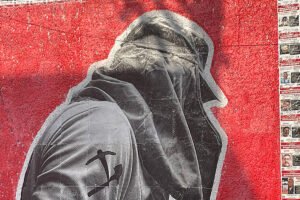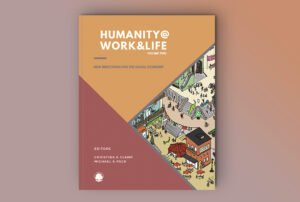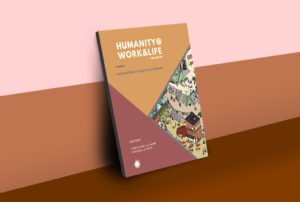
When it comes to identity, ideas about leadership generally reflect existing social hierarchies and binaries. There is plentiful scholarship on White leadership or traditional CEO leadership; the literature considers Black male leaders, female leaders, and Black female leaders to a lesser extent; and Indigenous people’s leadership is vastly underrepresented, typically explained as “minority leadership”. Unsurprisingly, the dominant narratives favor models that overlook multi-value-based identities (including age, class, ability, and so on), and rarely consider how these identities coalesce within coleadership dynamics rooted in social movements and Indigenous communities.
Part of the work of establishing an effective coleadership model is to unravel the complexity of integrating multifaceted identities into a cohesive leadership framework and advocating for a model that moves beyond traditional hierarchies to better reflect societal diversity. As leaders of varied ages, generational influences, gender identities, socioeconomic backgrounds, and cultural heritages are in the workforce, we grapple with honoring our authentic selves while conforming to a collective framework that effectively serves all.
We are all connected; our actions impact ourselves and the collective whole.
In “Building Resilient Organizations,” Maurice Mitchell asserts that individual impulses must not overshadow collective strategy. Yet, applying this in daily coleadership practices remains ambiguous at best. Reflecting on my own role in cocreating two social justice nonprofit organizations, I realize the importance of continuous self-reflection in the coleadership model.
Reflections on Leadership
bell hooks once said: “I think that all of us are called to question our participation in capitalism—this is the system we live within, this imperialist, White supremacist, capitalist patriarchy—where do I enter into that as a person with potential power to harm others, and what keeps me from engaging in those violent acts of estrangement?”
hooks challenges us to confront our roles in a system structured by imperialism, White supremacy, patriarchy, capitalism. We are all connected; our actions impact ourselves and the collective whole. When we make decisions as an “I” instead of a “we,” we fall victim to our ego and self-interest, becoming more susceptible to harming others. So, how do I, as a person in a position of power, navigate these dynamics without causing harm?
As a Black cisgendered woman, a first-generation college student from the deep South, and a person born in poverty, social justice movements have touched every aspect of my life. Despite the historical legacies of resource scarcity, divide-and-conquer tactics, violence, and the continued vulnerable context in the South—social movements are vital in the region, rooted in the necessity of solidarity and intersectional struggle. In those Southern movements, Black women and women of color have always had a central role—though often not explicitly acknowledged—in the stories about Southern movements and struggles or documented in the literature and history books.
Understanding the integral role of Black women in these movements underscores the importance of identity, shared leadership, and collective care that has always existed. But what does it mean to care for the collective, and are the practices best aligned for the good of the whole? How do we understand the role of self (and our identities) in this work? How do we acknowledge where we may be colluding with these systems? And how do we access what is needed to lead and make decisions that get us closer to our core values?
I do not have the answers, but I pose these questions to grow in my leadership as I struggle to identify with what is available in the field. To further explore these themes, I conducted a literature review of academic and peer group practice, interviews, and a survey. This allowed me to explore the praxis of coleadership, examining relationships, leadership, and the values and strategies they employ to lead these organizations.
View of the Self
To reflect on the questions above, one must attend to the intersectionality in coleadership, both within each individual with multiple identities and between people.
The role of and the perception of identities in the literature relating to coleadership is sparse. However, my research respondents emphasized that identity is a significant factor for them. As one respondent said, “My identity impacts how I show up and lead every day.” The intersecting identities of individuals and how others perceive them can’t be ignored. The respondent emphasized that she and her codirector intentionally built this awareness to better lead together.
For instance, an Asian American codirector’s experience highlights the complexity of intersectionality. Despite being a lifelong US resident, she may be perceived as a foreigner. In addition, she is cautious of the “model minority myth”—the stereotype that Asians in the United States are intelligent, well off, and able to excel in fields such as math and science—and how she can become tokenized. She is also cis-female in a male-dominated field. Staff may be biased to see her as proximate to Whiteness and the manager class rather than recognize her experience as a target of racism and misogyny.
Coleadership is not a one-time conversation but a continuous conversation.
Codirectors mentioned that discussions of experiences in the workplace and the movement through the lens of intersecting identities are needed. Understanding our coleadership identities through the lens of power and privilege and understanding how that plays out in decision-making is essential. Having an intersectional analysis informed by our multiple identities provides more rigor and depth to finding solutions to confront institutional structures and challenges. We can also use our perspective from complex identities to bring our lived experiences and show how communities are impacted differently.
I can bring in my upbringing, cultural experiences, and everyday lived experiences as a Black woman when I am working to organize Black women around poverty, economic issues, maternal health, and working with Black women from different backgrounds. In my time working at a domestic violence shelter, I worked with Black and African women immigrants about what support they needed for their household, what it means to be in a healthy relationship, identifying the safe places to get resources such as food, feminine supplies, and job opportunities—where they would not be judged, shamed, or misunderstood due to religious or cultural beliefs. While there may be a perception of their identity and needs externally, the religious and cultural needs are an added dimension that I had to recognize, understand, and embrace to build trust and relationships with these women from all walks of life.
We have to value each other as individuals with different and valuable experiences. When we learn who we are, where we’ve been, and what our stories are, we become vulnerable and empathic to each other’s experiences. We also learn the value and skills each person brings to the struggle. When we build relationships, we build community. When we build community, we can work with and through issues that affect us collectively.
Coleading Is Community
Coleadership is not a one-time conversation but a continuous conversation. In our research, codirectors expressed that they do not believe they could lead well if they didn’t continue to bring up these dynamics. They listen to each other before deciding how to advance the work. It takes time to get to know and understand each other’s perspectives. That understanding leads to the ways of working, their entry points into the work, how they see the world, and what that means about how they lead. By giving space to understand their coleader and build a collective leadership approach, it naturally interrupts the systems and structures rooted in the efficiency of capitalism and the individualism of White supremacy.
Sign up for our free newsletters
Subscribe to NPQ's newsletters to have our top stories delivered directly to your inbox.
By signing up, you agree to our privacy policy and terms of use, and to receive messages from NPQ and our partners.
In coleadership, power is a balancing dance. Power must be navigated explicitly and consciously, with a commitment to a mutual leadership relationship. It is through this voluntary exchange that we can engage in ideas, hard truths, and disagreements. In my experience, the heart of coleading is the processing, dialogue, and interrogation of our shared values. If the alignment is there, that is the easy part. But what happens when it is not?
Usually when there is misalignment, the decision-making process is stalled. When that happens, we engage in discussion to surface the disagreements. The processing is done so that it’s not just the person who speaks the last or loudest who wins. I have found that interrogating the initial disagreement helps get to the root of the disagreement. At the end of the process, something new has been learned.
By giving space to understand their co-leader and build a collective leadership approach, it naturally interrupts the systems and structures rooted in the efficiency of capitalism and the individualism of White supremacy.
For example, we all have different experiences related to resources that have provided underlying values associated with spending money. If you come from a background rooted in poverty and the other person comes from wealth, and one comes from a conservative perspective and scarcity because of your relationship with money, that can cause tension if the other person wants to spend all the resources to do the work. It can be hard to figure out the guiding principles used to make financial decisions. Ideally, there is an intentional process to ensure leaders are on the same page that allows them to unpack the perspectives and different values to come to a collective view of what will serve the whole.
Although coleadership frameworks are adaptive and allow organizations to expand and share power by addressing issues, there are challenges to this model. Directors must be mindful that they are not being taken advantage of, used against each other, or unknowingly causing confusion.
Miscommunication and confusion can also occur regarding decision-making processes. A staff member having an informal conversation with one leader can be mistaken for a decision that the other leader is unaware of. Alternatively, staff can intentionally go to one director for a decision and cut out the other. In these moments, the coleadership has to have consistent, accountable communication for the good of the whole.
Furthermore, directors we interviewed stressed the importance of knowing when to have a unified voice so there is no confusion or chaos related to sharing decisions that have been made. The challenges and tension are an opportunity to grow and learn, and the decisions from the disagreements can be more robust. There is no one way to find the appropriate solution, and there are many ways of doing coleadership. It is a journey that takes time, trial and error.
Subverting the Imperialist White Supremacist Heteropatriarchy Culture
Where White supremacy threatens to strip our knowledge of communal and community cultural practices away from our communities, we can develop a container to help hold how we colead in a way that is true to our values. We can reground in the reality that we have been doing coleadership for generations. We need to tap back into how we see, acknowledge, experience, and respect each other.
hooks started using the phrase imperialist White supremacist capitalist patriarchy to have some language that reminded her continuously of the interlocking systems of dominations that define our reality. It is not that one issue is the important issue—gender or race—but rather, as a Black woman, to understand what was happening to her at that time, and that all these systems are always functioning simultaneously in our lives. hooks’ term evokes a larger apparatus and political framework than White supremacy alone.
In social justice organizations, shared leadership helps us get closer to the collective ideals and can help hold the accountability needed, moving us from individual exceptionalism to unleashing the values and ideas of the collective “we.” By design, coleadership is an act of rebellion against the dominant culture by defying the longstanding, top-down hierarchical norm.
As the coleadership model emerges in the field, little literature exists on how the model addresses the culture of imperialist White supremacist heteropatriarchy, or how identities interact with oppressive systems in a coleader model.
Despite the lack of literature to guide organizational strategies, groups such as the Asian Pacific Environmental Network (APEN) conducted research to inform their decision to transition to their codirectorship model. APEN found that organizations choose a codirector model for several reasons, including better alignment of core values within shared leadership and democratic decision-making, complementary skills, organizational sustainability, disruption of the one-leader system, and the ability to accomplish more. Leadership should reflect those you serve and organize, and the codirector models help to achieve that. Coleadership models also disrupt the “dominant system of one charismatic leader,” which is rooted in extractive capitalism.
Calling Forth the Field
Social justice organizations exist to confront, challenge, disrupt, or reinvent systems and institutions while navigating an interlocking system of domination. In a coleadership model where the leaders are not conscious of the role of identity, how it shows up—particularly in power positions—could cause harm to the collective.
When we recognize our identity and how it shows up in different spaces, we are more powerful, bolder, and a better leader for the whole and for our coleaders. It is an asset to understand our power and strengths and how to lead from a truth and core that honors our essential selves without diminishing or devaluing others. Through this positioning, the collective is stronger to tackle our work.
Reflecting on what I’ve learned in my experience and exploration of coleadership frameworks, I realize there are still more questions and opportunities for exploration. As a field, leaders need to rethink what we know, assume, and practice as we seek new, bolder leadership frameworks that unleash creative thinking and imagination toward the next iteration of progressive change.








